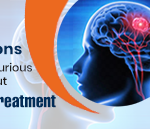Spinal Cord Disorder: Symptoms, Causes and Treatment
Spinal cord disorders are some of the most feared among all medical conditions. Because the spinal cord plays such an important role in bodily functions, it can be difficult to identify and treat spinal cord disorders properly. But with knowledge and care, many people can get back on their feet with spinal cord disorder treatment, making their lives better than ever before. Here’s everything you need to know about spinal cord disorders so that you or your loved one with a spinal condition can live happily and healthily.
What is a spinal cord disorder?
A spinal cord disorder is a condition that affects the spinal cord, which is the bundle of nerves that runs down the middle of your back. These disorders can cause pain, weakness, and numbness in your arms and legs. In severe cases, they can even lead to paralysis. There are many different types of spinal cord disorders, but some of the most common include :
Cervical spondylosis: a type of arthritis that affects the neck and lower back. It causes stiffness in the neck, pain, and muscle spasms. The symptoms may vary from person to person and can get worse over time. Medication for joint pain usually includes anti-inflammatory medications or cortisone injections.
Some Data About How Many People Are Suffering From This Disorder In India
Around 4.5 million people in India suffer from some form of spinal cord disorder, according to a report by the Indian Council of Medical Research (ICMR). That number is expected to rise to nearly 9 million by 2050. The most common disorders are spondylosis (a degenerative condition of the spine) and herniated discs.
Other disorders include scoliosis (a sideways curvature of the spine), kyphosis (excessive outward curvature of the spine), and spinal stenosis (narrowing of the spinal canal). All of these disorders can lead to pain, numbness, tingling, and weakness in the arms or legs. In severe cases, they can cause paralysis.
Most of these disorders stem from ageing, injury, obesity, poor posture, childbirth-related injuries, and infections such as HIV/AIDS. Treatments depend on the type of spinal cord disorder; however many doctors prescribe anti-inflammatory medications such as ibuprofen for temporary relief.
Milder cases may be treated with physical therapy and/or osteopathic manipulation techniques that may help decrease inflammation in the back muscles and joints.
Causes of spinal cord disorders
There are many different causes of spinal cord disorders, including:
1. Traumatic injuries to the spine
2. Viral or bacterial infections
3. Diseases like cancer or polio
4. Degenerative conditions like arthritis can cause degeneration in the spinal cord.
5. Several viruses and bacteria can lead to inflammation and scarring in the spinal cord, which may lead to chronic pain.
6. Spinal surgery is also a risk factor for developing a spinal cord disorder.
7. Radiation therapy can cause radiation myelopathy that leads to numbness and tingling sensations in your legs.
8. Many forms of cancer will metastasize (spread) into your brain stem, which can eventually spread into your spine and cause back pain due to nerve damage.
Symptoms of Spinal Cord Disorders
Spinal cord disorders can cause a wide range of symptoms, depending on the specific condition. Symptoms may include pain, numbness, weakness, and paralysis. In some cases, people with a spinal cord disorder may also experience changes in sensation, sexual function, and bowel or bladder control. In severe cases, a spinal cord disorder can be life-threatening.
The symptoms of a spinal cord disorder can vary widely depending on the type of disorder and where it occurs. If you have any signs or symptoms that are concerning for you, contact your doctor as soon as possible.
Several things may make it difficult for doctors to diagnose spinal cord disorders, including:
1. The fact that many diseases have similar signs and symptoms
2. Lack of sensitivity for imaging tests like X-rays
3. Inability to perform certain diagnostic tests because an individual is unable to move due to their disability
Treatment for Spinal cord disorders
There is no one-size-fits-all treatment for spinal cord disorders, as the best course of action will vary depending on the underlying cause. In some cases, medication may be used to manage symptoms, while in others, surgery may be necessary.
Physical therapy and lifestyle changes are often recommended as well. The most important thing is to work with a team of medical professionals to create a plan that is tailored to your specific needs. When it comes to physical therapy, there are many different types available – each appropriate for certain conditions.
For instance, water therapy can help those who have suffered an injury or stroke by promoting weight bearing and exercise.
In other cases, patients may need occupational or speech therapies to help them recover their quality of life.
Latest Research conducted for Spinal Cord Disorder (Only Names)
About 18,000 people suffer from spinal cord disorders each year. Spinal cord disorders can cause a variety of symptoms, including paralysis, loss of sensation, and muscle weakness.
While there is no cure for spinal cord disorders, there are treatments available that can help improve quality of life. The latest research shows that stem cell therapy may be a promising treatment option for people with spinal cord disorders.
Stem cells, which can be taken from fat or bone marrow in the body, have been found to work as replacements for damaged cells in the spine. Stem cells produce important chemicals called neurotransmitters that regulate communication between brain cells and different parts of the body. Researchers hope this will lead to new treatments for spinal cord disorders like ALS (Lou Gehrig’s disease).
Conclusion
According to data, approximately 12,000 people live with spinal cord injuries (SCI). SCI can be devastating and can impact your quality of life in many ways. Luckily, many treatments are available that can help manage symptoms and improve your ability to move around and enjoy life even if you’ve had an SCI. Learn more about SCI and how you can deal with it with these essential tips.

 Previous Post
Previous Post Next Post
Next Post